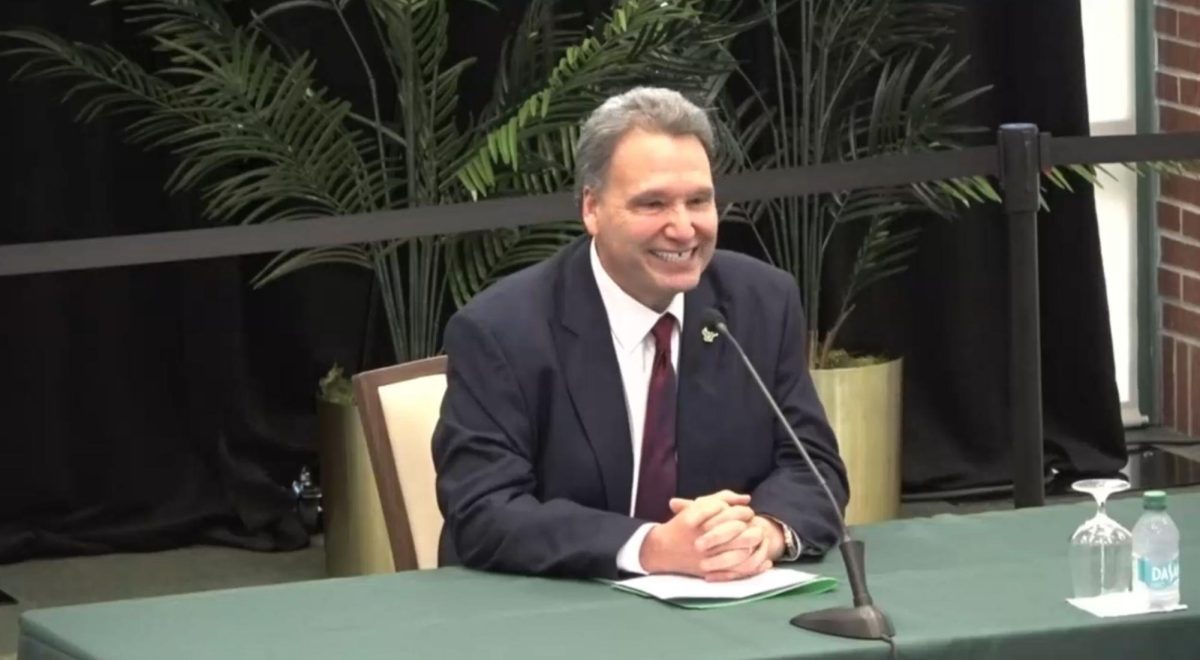 Lecturer visits UNF, gives five steps to reduce stress
Lecturer visits UNF, gives five steps to reduce stress
School work, exams, papers, weight and time management, jobs, finances and a social life. College students attempt to juggle all these activities and more. Balancing these things often leads to negative emotions such as anger, frustration, exhaustion, tension, resentment, fear and even panic.
Thirty-three percent of Americans live with extreme stress and 48 percent believe their stress has increased over the past five years, according to a 2007 stress survey by the American Psychological Association.
While a normal amount of stress serves as a motivator for action, too much stress might have a negative impact on mental and physical health. Many available outlets help reduce stress and build new habits for a healthier lifestyle.
Psychologist Dr. Bill Crawford, author of “Life From the Top of the Mind,” visited the University Center Oct. 3 to discuss some of these outlets. Although he started 25 years ago, Crawford continues to create presentations and give speeches to organizations across the country.
“Stress is a valuable signal telling us we have a problem and we need to make a change, to find a solution,” he said.
Crawford spoke about a five-step approach to combating negative stress that shifts awareness to the upper 80 percent of the brain — an area that allows access to the clarity, confidence, creativity and skills necessary for success.
“It is not overloading,” said audience member Pat Allen. “He keeps it fun and down to earth.”
Dr. Crawford said everyone should raise the importance of their peace of mind.
“When you have diarrhea, you stop driving on the freeway or talking on the phone. Nobody says, ‘I’ll just deal with this later,’” Crawford said. “Serenity and using the more intelligent part of your mind should be at least as important as diarrhea.”
So next time an exams has gets you hyperventilating as time slips through your fingers and essays cause you to pull out your hair, remember to use your B.R.A.I.N. — the five step system to reducing stress.
1. Breathe.
“We need to get back in control, and our breath is one thing we have control over,” Crawford said.
When stressful situations arise, your limbic system allows your neocortex (the lower 20 percent of your brain) to take over, spiraling your senses into “fight or flight” mode. Crawford said taking three to five deep inhales and saying “relax” on the exhale will help shift brain function back to the higher-thinking portion. Breathing deeply will gradually lead you into the next step.
2. Relax.
Find an inner serenity, Crawford said.
“We live in a society that says, ‘If you’re not stressed, you must not have enough to do,’” Crawford said. “’If you’re not stressed, you must not care.’”
Relaxation is related to being lazy and a slacker, but he said you need to drop that mind block, which will make relaxation easier.
“We need to redefine the word relaxation,” Crawford said. “Accept the things we cannot change so we can find the wisdom to deal with the things we can change.”
After breathing and relaxing, you can solve the problem with more clarity.
3. Ask.
When upset, questions arise about the source of the problem, Crawford said.
“’That guy just cut me off. What is wrong with him? I have to pay these bills. Where am I going to get the money? How can I memorize all these equations? How will I make the time to do all this homework?’” Crawford said.
He said it’s better to ask, “How would I rather feel?” This strategy puts you in charge, letting you decide to feel calm, peace or energy. After deciding how to feel, it’s time to try and actually feel it.
4. Imagine.
“Ask yourself, ‘Have I felt this way before?’ And then bring that past feeling into the present and the future,” Crawford said.
Imagine what it would be like if you were feeling patient or confident in a stressful situation, he said.
“It would change your response to the situation. Chemically, mentally, it would mean you would have access to clarity, confidence and creativity,” Crawford said.
5. Notice.
“It is important to notice that you are feeling more clarity confidence and creativity,” Crawford said. “Plus the ‘n’ in ‘notice’ helps me spell the word ‘B.R.A.I.N.’ I like my models to spell things.”
According to Crawford, all five of these steps can be completed in about 10 to 15 seconds.
















Kimberly | Dec 9, 2009 at 9:12 pm
Great Post! I love to read articles that are informative and beneficial in nature. Thank You for sharing your knowledge.
Gregory | Dec 9, 2009 at 6:23 pm
Thank you, I love to read articles that are informative and beneficial in nature.
Adele | Oct 8, 2009 at 3:53 pm
Thank you so much for this article. Dr. Bill Crawfords work is timely. Hope others will want to receive more info on his work and apply it to their lives. It has definitely assisted me in knowing when I am working from the top of my mind or flying away from a situation. His work certainly provides the tools and the education to become more creative in having the life we really want and having the clarity to know the way.